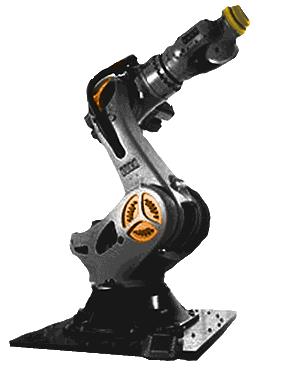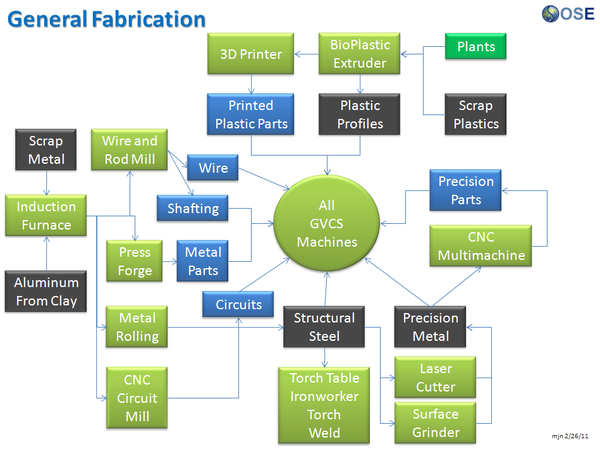Industrial Robot: Difference between revisions
No edit summary |
|||
| (35 intermediate revisions by 9 users not shown) | |||
| Line 1: | Line 1: | ||
{{OrigLang}} | |||
{{GVCS Header}} | |||
==Overview== | |||
[[Image:IndustrialRobot.jpg|thumb|400px|Industrial Robot Arm]] | |||
The industrial robot is an automated machine that perform a wide variety of functions, (including [[welding]], assembly, and [[CAM]], etc...), all depending on which tools its hand is equipped with. | |||
{{Video}} | |||
This is the [http://www.youtube.com/watch?feature=player_embedded&v=FvRTHynk9KA#t=37s kind of thing] you can do with a top-of-the-line industrial robot. | |||
==Detailed Description== | |||
The industrial robot is a rotating multi-axis machine that can hold various modules (called end-effectors) for performing different tasks such as welding and cutting. These tasks can be done in repetition (through proper "teaching") and with precision (based on the robot's repeatability, which is a measure of how far the robot deviates from a certain position when going there multiple times). The volume in which the robotic arm can travel is called the working envelope (rear of robot is typically restricted), and the axes of rotation are called degrees of freedom (6 or more for higher-end flexibility). A versatile industrial robot can significantly improve the accuracy, precision, and completion times of multiple production tasks while significantly reducing the need for operator involvement. | |||
[[ | The industrial robot is task versatile, multi-way programmable, repeatably accurate, and modular with scalable reach and payload. The industrial robot serves a universal function mimicking a human arm, so can fill in (after being programmed) for any repetitive operation not better done by humans; other times, the industrial robot can be directly operator-controlled to act as a mega-arm machine where the high reach, payload, and working envelope are advantaged. | ||
==Product Ecology== | |||
[[Image:2b-Genfabecology.png|right|600px|Industrial Robot [[Product Ecology]]]] | |||
{{Product Ecology | |||
|Product ={{Industrial Robot}} | |||
|From= | |||
*{{Induction Furnace}} | |||
*{{Motors}} | |||
*{{Welder}} | |||
*{{Torch}} | |||
|Uses= | |||
*{{Welder}} | |||
*[[Electricity]] | |||
|Creates= | |||
*[[Welding]] | |||
*[[Painting]] | |||
|Enables= | |||
*{{Car}} | |||
*{{Truck}} | |||
|Components= | |||
}} | |||
==Status== | |||
The '''Industrial Robot''' is currently entering the [[Industrial_Robot/Research_Development|prototype phase of production.]] | |||
==See Also== | |||
*[[3D Printed Robotic Arm]] | |||
*[[Open Source Robotic Arm Construction Set]] | |||
*[[Robotic Cell]] | |||
==Useful Links== | |||
*[http://en.wikipedia.org/wiki/Industrial_robot Wikipedia: Industrial Robot] | |||
*[https://www.kickstarter.com/projects/ufactory/uarm-put-a-miniature-industrial-robot-arm-on-your Open source 4 axis robot] | |||
*[https://www.youtube.com/watch?v=clXfkccGDEg A Video by the Youtube Channel "Skyentific" on humanoid robotic arms] | |||
{{GVCS Footer}} | |||
Latest revision as of 16:08, 28 July 2023
| Industrial Robot | ||
|---|---|---|
| Home | Research & Development | Bill of Materials | Manufacturing Instructions | User's Manual | User Reviews | 
| |
Overview
The industrial robot is an automated machine that perform a wide variety of functions, (including welding, assembly, and CAM, etc...), all depending on which tools its hand is equipped with.
This is the kind of thing you can do with a top-of-the-line industrial robot.
Detailed Description
The industrial robot is a rotating multi-axis machine that can hold various modules (called end-effectors) for performing different tasks such as welding and cutting. These tasks can be done in repetition (through proper "teaching") and with precision (based on the robot's repeatability, which is a measure of how far the robot deviates from a certain position when going there multiple times). The volume in which the robotic arm can travel is called the working envelope (rear of robot is typically restricted), and the axes of rotation are called degrees of freedom (6 or more for higher-end flexibility). A versatile industrial robot can significantly improve the accuracy, precision, and completion times of multiple production tasks while significantly reducing the need for operator involvement.
The industrial robot is task versatile, multi-way programmable, repeatably accurate, and modular with scalable reach and payload. The industrial robot serves a universal function mimicking a human arm, so can fill in (after being programmed) for any repetitive operation not better done by humans; other times, the industrial robot can be directly operator-controlled to act as a mega-arm machine where the high reach, payload, and working envelope are advantaged.
Product Ecology
| From | Uses | Creates | Enables |
|---|---|---|---|
|
Components |
Status
The Industrial Robot is currently entering the prototype phase of production.
See Also
Useful Links
- Wikipedia: Industrial Robot
- Open source 4 axis robot
- A Video by the Youtube Channel "Skyentific" on humanoid robotic arms








